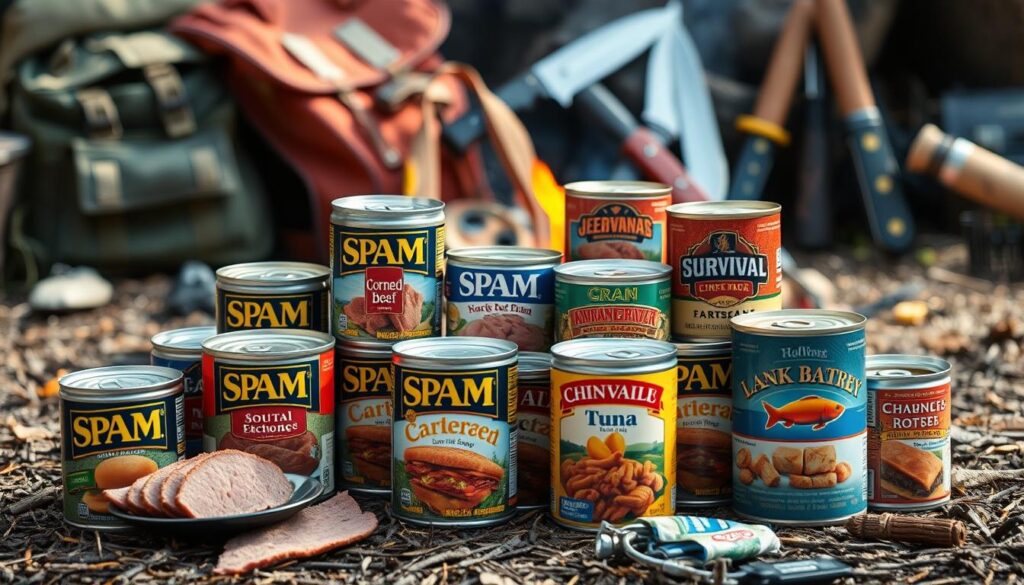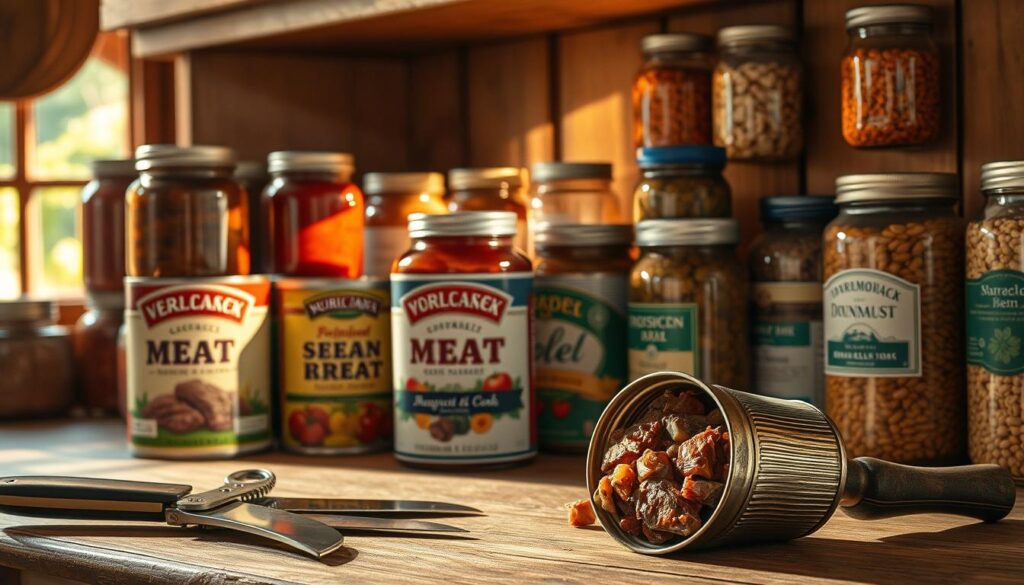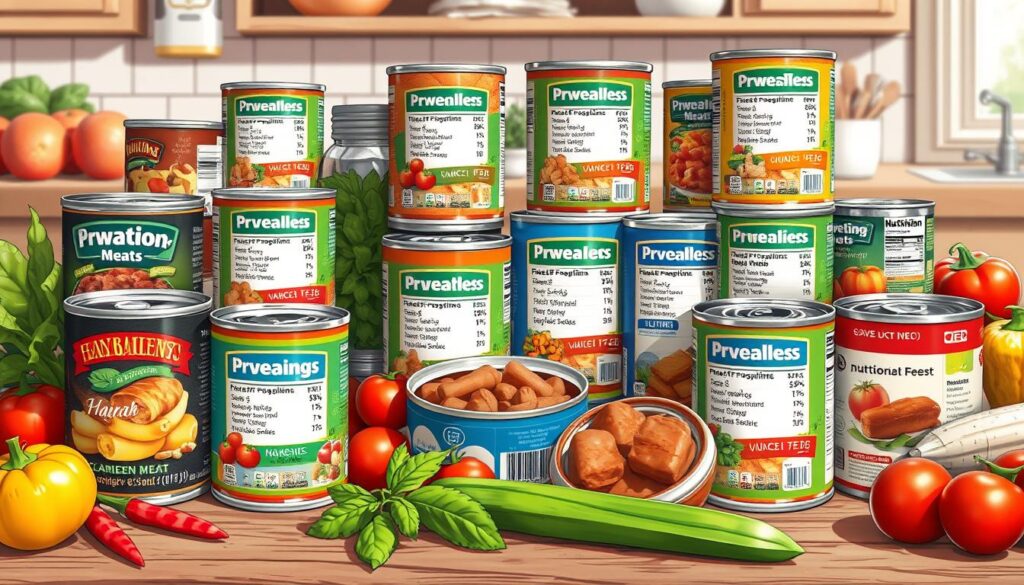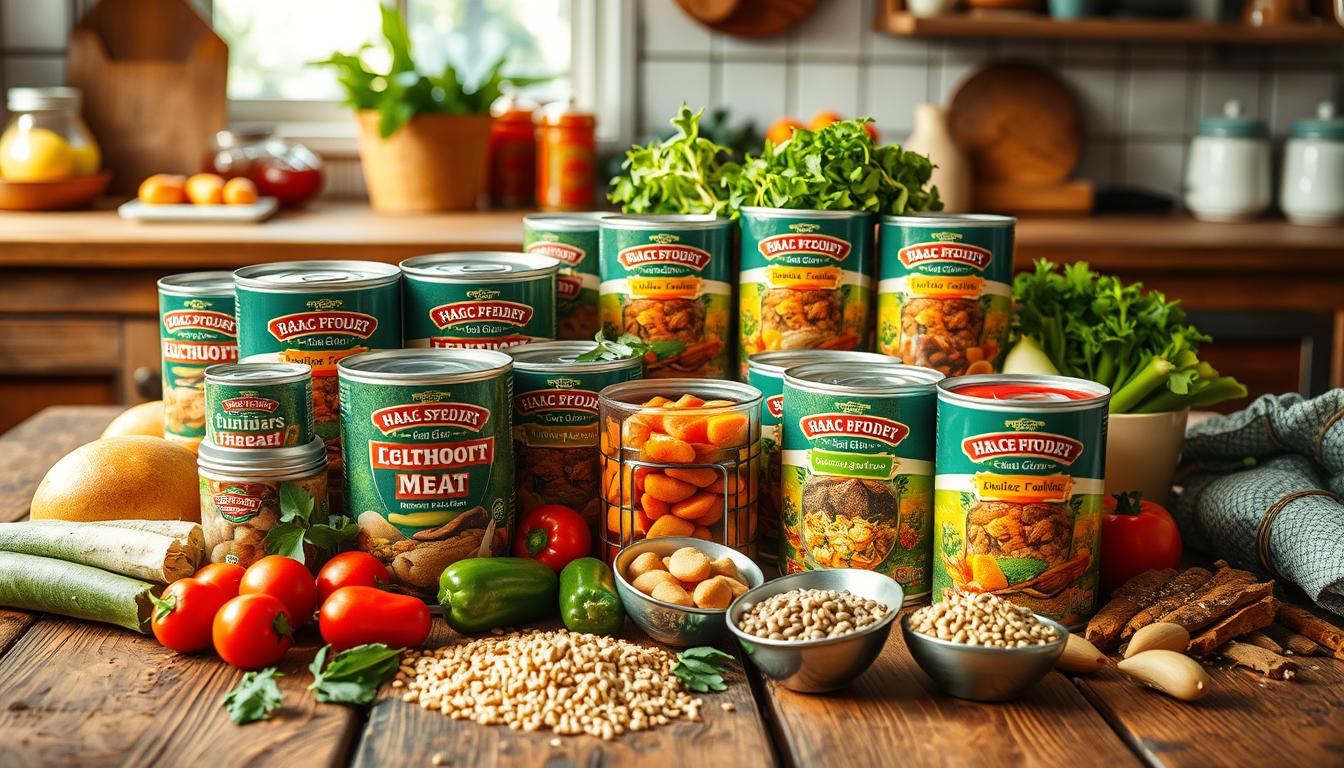Ever thought about living on just canned meat for six months? I tried it, and it changed how I see food and self-sufficiency. Canned meat is full of flavors, lasts a long time, and is very practical. It’s a key item for anyone looking into food storage.
My adventure showed me canned meat is more than just for survival. It’s vital for homesteading and prepping. Many homesteaders want to store food for a year. Canned meat helps save time, money, and gives peace of mind during emergencies. Let’s dive into my experience, covering nutrition, challenges, and tips for food security.
Key Takeaways
- Canned meat is a practical choice for long-term food storage and prepping.
- Many homesteaders aim to stock at least a year’s worth of supplies.
- Buying in bulk often reduces costs and waste.
- Preparedness helps during unexpected emergencies and job losses.
- Proper inventory management is crucial to prevent food waste.
- Canned goods can provide essential nutrients while being shelf-stable.
- Storing food in optimal conditions can extend its shelf life significantly.
The Appeal of Canned Meat for Preppers
Canned meat is a favorite among preppers for its durability and versatility. Products like Yoder’s Canned Bacon offer up to 40 slices per can, lasting up to 10 years. This makes it a key item for emergency preparedness.
Yoder’s Canned Hamburger, made using Amish methods, weighs 28 ounces. It’s a reliable protein source for those preparing for emergencies.
In today’s world, having food security is crucial. Items like SPAM and DAK Canned Ham are essential for a prepper’s pantry. SPAM, developed for the U.S. Army in 1937, is a classic choice for its convenience.
Canned meat not only provides nutrition but also adds flavor to meals. It helps keep spirits high during challenging times.
Having a variety of canned meats in your pantry is vital. Options like Hormel Chunk Lean Smoked Canned Ham and Underwood’s Deviled Ham Spread offer essential protein. This variety boosts both dietary diversity and mental well-being, making preppers feel more prepared.

| Product | Weight/Quantity | Shelf Life | Origin/Brand |
|---|---|---|---|
| Yoder’s Canned Bacon | 40 slices | 10 years | Yoder’s |
| Yoder’s Canned Hamburger | 28 ounces | 40+ years | Yoder’s |
| DAK Canned Ham | 1 pound | 2-5 years | DAK |
| SPAM | 12 ounces | 2-5 years | Hormel |
| Hormel Chunk Lean Smoked Canned Ham | 12 ounces | 2-5 years | Hormel |
| Underwood’s Deviled Ham Spread | 3.25 ounces | 3 years | Underwood |
| Keystone Ground Beef | 28 ounces | 2-5 years | Keystone |
For preppers, canned meat is more than just a survival tool. It’s a symbol of self-sufficiency. A well-stocked pantry with canned meat products offers peace of mind and sustenance in times of need.
My Journey: Eating Only Canned Meat for Six Months
I started eating only canned meat for six months as an experiment. It was a way to save money and use up items that were close to expiring. This change helped me improve my food security and learn about prepping.
During this time, I found canned meat to be incredibly convenient. I could make a variety of dishes with tuna, chicken, beef, and spam. It made cooking easy and fun, without needing to plan or shop a lot.
This experience showed me how adaptable I could be. Each can of meat could make a satisfying meal, making cooking interesting and efficient. I learned to appreciate the benefits of storing canned goods for food security.
This shift was key for preparing for emergencies. The pandemic showed us how vulnerable our food supply can be. My experience with canned meat helped me build a reliable food stockpile. It taught me the importance of having food ready for uncertain times.

How Canned Meat Fared in Terms of Nutrition
Canned meat is a convenient protein source, making it popular for food security. During my six-month diet of only canned meat, I focused on its nutrition. I found both good and bad points about its health effects.
Most canned meats have 20-25 grams of protein per serving, which is good for my protein needs. However, I struggled with high sodium levels. Many cans have 300 to 900 mg of sodium per serving. This led to higher blood pressure, showing the health risks of canned meat.

Despite health concerns, canned meat has benefits. It can last three to five years when stored right, offering long-term food security. Studies show canned meats keep 85-90% of their nutrients, which was encouraging during my experiment.
It’s important to find a balance. Canned meat is cheaper, costing $2 to $5 per can. But, I had to be careful with my choices. Also, canned meats can have 15-30% fat, depending on the type. My six months of eating only canned meat made me think about convenience versus health risks, especially sodium and nutrition.
Challenges Faced During the Experiment
Starting a six-month diet of only canned meat was tough. It changed my life and health a lot. My blood pressure went up, and I worried about too much sodium. Keeping an eye on my health was key.
Eating the same canned meat every day got boring. I tried new recipes to make meals fun again. Adding spices and sauces made a big difference, keeping things interesting.
I worked hard to add variety to my diet. Here’s what I did:
- Experimenting with different brands and flavors of canned meat
- Combining canned meat with other pantry staples like rice and beans
- Utilizing herbs and spices to enhance flavors
But, the long-term effects of eating only canned meat were a big worry. It’s important to eat a balanced diet. So, I tried to use other foods whenever I could.
| Challenge | Impact | Strategy |
|---|---|---|
| Health impacts | Elevated blood pressure | Monitor sodium intake |
| Boredom | Monotonous diet | Creative meal preparation |
| Diet Variation | Lack of nutrition | Incorporate other pantry staples |
This experience taught me a lot about being flexible and creative with food. It showed me how important it is to mix things up and watch your health when eating mostly one type of food for a long time.
Benefits of Canned Meat for Food Security and Homesteading
Canned meat is key for food security and homesteading. Families have preserved food for winter for over a hundred years. This shows canned goods’ long shelf life and energy efficiency in emergencies.
Having a prepper pantry with canned meat boosts self-sufficiency. It’s great for homesteaders. The idea of “Store what you eat and eat what you store” is crucial. It helps match food supplies to your needs.
Using the “first in, first out” rule can reduce waste. This ensures older items are eaten first. A well-stocked pantry acts as a safety net during hard times, improving food security.
Combining homegrown food with canned options is a strong strategy. It fits well with sustainable living. Many families today are learning traditional food preservation skills.
To show canned meat’s benefits for food security and homesteading, here’s a table:
| Benefit | Description | Example |
|---|---|---|
| Long Shelf Life | Canned meat can last for several years, ensuring food availability during emergencies. | Typically lasts up to 10 years when stored properly. |
| Simplicity of Storage | Requires little space and minimal energy for storage, making it ideal for many households. | Fits easily into smaller cabinets or storage areas. |
| Self-Reliance | Reduces dependency on store-bought, perishable items. | Encourages personal gardening and canning practices. |
| Emergency Preparedness | Acts as a buffer during unexpected food shortages. | Having a year’s supply can safeguard against crises. |
Adding canned meat to my routine boosts food security and supports sustainable living. The trend towards homesteading shows a return to essential skills. It helps us thrive through self-sustained practices.
Strategies for Canning Your Own Meat
Canning meat at home boosts self-sufficiency and food security. It also teaches essential prepper skills. By learning DIY canning, I get fresher, tastier meat without chemical preservatives. Here are some strategies to start.
- Choose the Right Cuts: Pick meats that can handle canning well. Beef, lamb, venison, elk, and moose are good choices.
- Understand the Canning Process: You need a pressure canner for meat since it’s low-acid. Canning time is usually 90 minutes at 10 pounds of pressure. But, it can change with elevation.
- Prepare Your Jars: Fill jars to the shoulder, leaving 1 inch of space. Each quart jar needs about 1 teaspoon of salt for flavor, but it’s optional.
- Steam Venting: Let steam vent for 10 minutes before adding weight to your canner. This ensures jars seal well.
- Natural Cooling: After canning, let jars cool naturally for 16 to 24 hours. This helps them seal tightly.
Keeping a well-stocked pantry ensures a steady food supply. Goals range from two weeks to a year. Buying in bulk saves money. It also reduces waste from packaging.
Focus on foods that last long when planning for preservation. Beans and rice can last a year or more. Ready-to-eat meals for at least two days avoid last-minute shopping. Store dry goods in airtight containers for protection.
Buying from local growers helps get fresh produce, especially during tough times. Growing and preserving food myself improves nutrition and value. Canning enhances flavor, making delicious broths from natural juices. It also frees up freezer space, especially when buying meat in bulk or hunting.
| Strategy | Benefits |
|---|---|
| Choose the Right Cuts | Ensures quality and flavor retention |
| Understand the Canning Process | Ensures safety and efficiency |
| Prepare Your Jars | Promotes proper sealing and flavoring |
| Steam Venting | Prevents jar breakage and ensures airtight seals |
| Natural Cooling | Enhances seal integrity for long-term storage |
Conclusion
Looking back, my six-month diet of only canned meat taught me a lot about nutrition. It showed how canned meat can be a reliable food source when we need it most. But it also taught me the value of having a variety of foods for a sustainable lifestyle.
This experiment showed me that canned meat is just one part of a good food plan. Many homesteaders dream of being completely self-sufficient. By making my own canned food, I can create a pantry that suits my taste and needs. This makes me more ready for any challenge.
In the end, my exploration of homesteading and canned meat showed they can work well together. Whether you’re a prepper, homesteader, or a bit of both, learning to preserve food is key. This journey towards sustainable living is ongoing, but using canned meat wisely has made me more flexible and prepared for the future.





